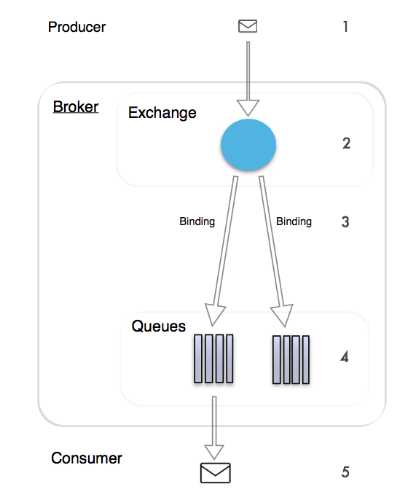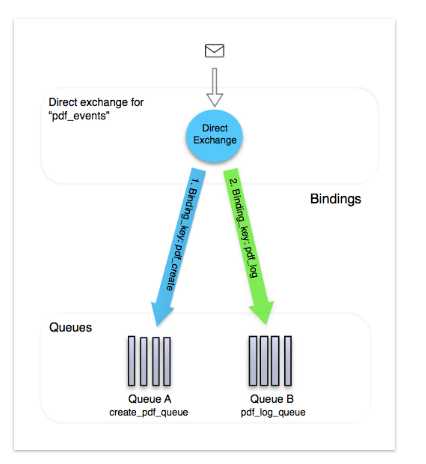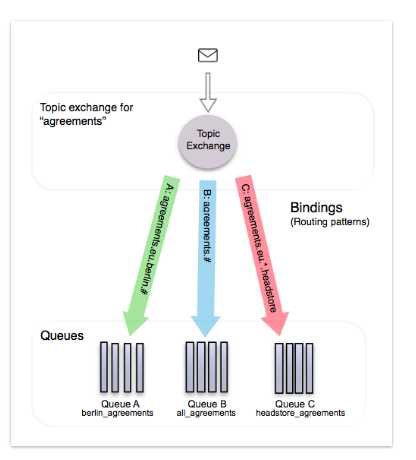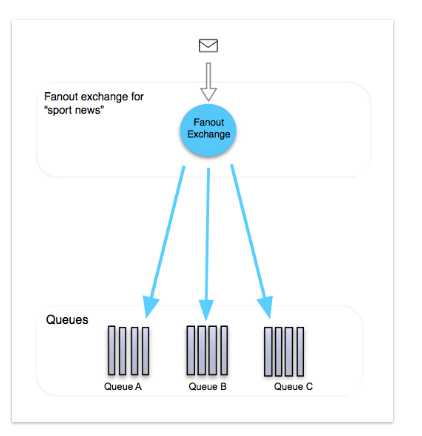标签:bit 通配符 str 相同 eve var let 技术分享 规则
在上一篇文章中,我们知道了RabbitMQ的消息流程如下:

但在具体的使用中,我们还需知道exchange的类型,因为不同的类型对应不同的队列和路由规则。
在rabbitmq中,exchange有4个类型:direct,topic,fanout,header。
此类型的exchange路由规则很简单:
exchange在和queue进行binding时会设置routingkey
channel.QueueBind(queue: "create_pdf_queue", exchange: "pdf_events", routingKey: "pdf_create", arguments: null);
然后我们在将消息发送到exchange时会设置对应的routingkey:
channel.BasicPublish(exchange: "pdf_events", routingKey: "pdf_create", basicProperties: properties, body: body);
在direct类型的exchange中,只有这两个routingkey完全相同,exchange才会选择对应的binging进行消息路由。
具体的流程如下:

通过代码可以会理解好一点:
var factory = new ConnectionFactory() { HostName = "localhost" }; using (var connection = factory.CreateConnection()) using (var channel = connection.CreateModel()) { // Direct类型的exchange, 名称 pdf_events channel.ExchangeDeclare(exchange: "pdf_events", type: ExchangeType.Direct, durable: true, autoDelete: false, arguments: null); // 创建create_pdf_queue队列 channel.QueueDeclare(queue: "create_pdf_queue", durable: true, exclusive: false, autoDelete: false, arguments: null); //创建 pdf_log_queue队列 channel.QueueDeclare(queue: "pdf_log_queue", durable: true, exclusive: false, autoDelete: false, arguments: null); //绑定 pdf_events --> create_pdf_queue 使用routingkey:pdf_create channel.QueueBind(queue: "create_pdf_queue", exchange: "pdf_events", routingKey: "pdf_create", arguments: null); //绑定 pdf_events --> pdf_log_queue 使用routingkey:pdf_log channel.QueueBind(queue: "pdf_log_queue", exchange: "pdf_events", routingKey: "pdf_log", arguments: null); var message = "Demo some pdf creating..."; var body = Encoding.UTF8.GetBytes(message); var properties = channel.CreateBasicProperties(); properties.Persistent = true; //发送消息到exchange :pdf_events ,使用routingkey: pdf_create //通过binding routinekey的比较,次消息会路由到队列 create_pdf_queue channel.BasicPublish(exchange: "pdf_events", routingKey: "pdf_create", basicProperties: properties, body: body); message = "pdf loging ..."; body = Encoding.UTF8.GetBytes(message); properties = channel.CreateBasicProperties(); properties.Persistent = true; //发送消息到exchange :pdf_events ,使用routingkey: pdf_log //通过binding routinekey的比较,次消息会路由到队列 pdf_log_queue channel.BasicPublish(exchange: "pdf_events", routingKey: "pdf_log", basicProperties: properties, body: body); }
此类型exchange和上面的direct类型差不多,但direct类型要求routingkey完全相等,这里的routingkey可以有通配符:‘*‘,‘#‘.
其中‘*‘表示匹配一个单词, ‘#‘则表示匹配没有或者多个单词

如上图第一个binding:
第二个binding:
第三个binding:
所以如果我们消息的routingkey为agreements.eu.berlin那么符合第一和第二个binding,但最后一个不符合,具体的代码如下:
var factory = new ConnectionFactory() { HostName = "localhost" }; using (var connection = factory.CreateConnection()) using (var channel = connection.CreateModel()) { // Topic类型的exchange, 名称 agreements channel.ExchangeDeclare(exchange: "agreements", type: ExchangeType.Topic, durable: true, autoDelete: false, arguments: null); // 创建berlin_agreements队列 channel.QueueDeclare(queue: "berlin_agreements", durable: true, exclusive: false, autoDelete: false, arguments: null); //创建 all_agreements 队列 channel.QueueDeclare(queue: "all_agreements", durable: true, exclusive: false, autoDelete: false, arguments: null); //创建 headstore_agreements 队列 channel.QueueDeclare(queue: "headstore_agreements", durable: true, exclusive: false, autoDelete: false, arguments: null); //绑定 agreements --> berlin_agreements 使用routingkey:agreements.eu.berlin.# channel.QueueBind(queue: "berlin_agreements", exchange: "agreements", routingKey: "agreements.eu.berlin.#", arguments: null); //绑定 agreements --> all_agreements 使用routingkey:agreements.# channel.QueueBind(queue: "all_agreements", exchange: "agreements", routingKey: "agreements.#", arguments: null); //绑定 agreements --> headstore_agreements 使用routingkey:agreements.eu.*.headstore channel.QueueBind(queue: "headstore_agreements", exchange: "agreements", routingKey: "agreements.eu.*.headstore", arguments: null); var message = "hello world"; var body = Encoding.UTF8.GetBytes(message); var properties = channel.CreateBasicProperties(); properties.Persistent = true; //发送消息到exchange :agreements ,使用routingkey: agreements.eu.berlin //agreements.eu.berlin 匹配 agreements.eu.berlin.# 和agreements.# //agreements.eu.berlin 不匹配 agreements.eu.*.headstore //最终次消息会路由到队里:berlin_agreements(agreements.eu.berlin.#) 和 all_agreements(agreements.#) channel.BasicPublish(exchange: "agreements", routingKey: "agreements.eu.berlin", basicProperties: properties, body: body); }
此exchange的路由规则很简单直接将消息路由到所有绑定的队列中,无须对消息的routingkey进行匹配操作。

此类型的exchange和以上三个都不一样,其路由的规则是根据header来判断,其中的header就是以下方法的arguments参数:
Dictionary<string, object> aHeader = new Dictionary<string, object>(); aHeader.Add("format", "pdf"); aHeader.Add("type", "report"); aHeader.Add("x-match", "all"); channel.QueueBind(queue: "queue.A", exchange: "agreements", routingKey: string.Empty, arguments: aHeader);
其中的x-match为特殊的header,可以为all则表示要匹配所有的header,如果为any则表示只要匹配其中的一个header即可。
在发布消息的时候就需要传入header值:
var properties = channel.CreateBasicProperties(); properties.Persistent = true; Dictionary<string, object> mHeader1 = new Dictionary<string, object>(); mHeader1.Add("format", "pdf"); mHeader1.Add("type", "report"); properties.Headers = mHeader1;
具体的规则可以看以下代码:
var factory = new ConnectionFactory() { HostName = "localhost" }; using (var connection = factory.CreateConnection()) using (var channel = connection.CreateModel()) { // Headers类型的exchange, 名称 agreements channel.ExchangeDeclare(exchange: "agreements", type: ExchangeType.Headers, durable: true, autoDelete: false, arguments: null); // 创建queue.A队列 channel.QueueDeclare(queue: "queue.A", durable: true, exclusive: false, autoDelete: false, arguments: null); //创建 queue.B 队列 channel.QueueDeclare(queue: "queue.B", durable: true, exclusive: false, autoDelete: false, arguments: null); //创建 queue.C 队列 channel.QueueDeclare(queue: "queue.C", durable: true, exclusive: false, autoDelete: false, arguments: null); //绑定 agreements --> queue.A 使用arguments (format=pdf, type=report, x-match=all) Dictionary<string, object> aHeader = new Dictionary<string, object>(); aHeader.Add("format", "pdf"); aHeader.Add("type", "report"); aHeader.Add("x-match", "all"); channel.QueueBind(queue: "queue.A", exchange: "agreements", routingKey: string.Empty, arguments: aHeader); //绑定 agreements --> queue.B 使用arguments (format=pdf, type=log, x-match=any) Dictionary<string, object> bHeader = new Dictionary<string, object>(); bHeader.Add("format", "pdf"); bHeader.Add("type", "log"); bHeader.Add("x-match", "any"); channel.QueueBind(queue: "queue.B", exchange: "agreements", routingKey: string.Empty, arguments: bHeader); //绑定 agreements --> queue.C 使用arguments (format=zip, type=report, x-match=all) Dictionary<string, object> cHeader = new Dictionary<string, object>(); cHeader.Add("format", "zip"); cHeader.Add("type", "report"); cHeader.Add("x-match", "all"); channel.QueueBind(queue: "queue.C", exchange: "agreements", routingKey: string.Empty, arguments: cHeader); string message1 = "hello world"; var body = Encoding.UTF8.GetBytes(message1); var properties = channel.CreateBasicProperties(); properties.Persistent = true; Dictionary<string, object> mHeader1 = new Dictionary<string, object>(); mHeader1.Add("format", "pdf"); mHeader1.Add("type", "report"); properties.Headers = mHeader1; //此消息路由到 queue.A 和 queue.B //queue.A 的binding (format=pdf, type=report, x-match=all) //queue.B 的binding (format = pdf, type = log, x - match = any) channel.BasicPublish(exchange: "agreements", routingKey: string.Empty, basicProperties: properties, body: body); string message2 = "hello world"; body = Encoding.UTF8.GetBytes(message2); properties = channel.CreateBasicProperties(); properties.Persistent = true; Dictionary<string, object> mHeader2 = new Dictionary<string, object>(); mHeader2.Add("type", "log"); properties.Headers = mHeader2; //x-match 配置queue.B //queue.B 的binding (format = pdf, type = log, x-match = any) channel.BasicPublish(exchange: "agreements", routingKey: string.Empty, basicProperties: properties, body: body); string message3= "hello world"; body = Encoding.UTF8.GetBytes(message3); properties = channel.CreateBasicProperties(); properties.Persistent = true; Dictionary<string, object> mHeader3 = new Dictionary<string, object>(); mHeader3.Add("format", "zip"); properties.Headers = mHeader3; //配置失败,不会被路由 channel.BasicPublish(exchange: "agreements", routingKey: string.Empty, basicProperties: properties, body: body); }
以上就是exchange 类型的总结,一般来说direct和topic用来具体的路由消息,如果要用广播的消息一般用fanout的exchange。
header类型用的比较少,但还是知道一点好。
标签:bit 通配符 str 相同 eve var let 技术分享 规则
原文地址:http://www.cnblogs.com/julyluo/p/6265775.html